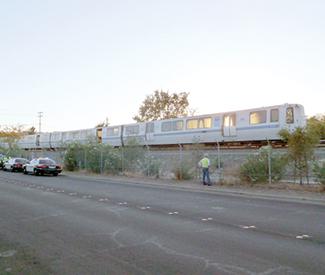BART continues to stonewall important questions about whether it was training scab drivers to break the recent strike by its unions when its trainee-driven train killed two workers on Oct. 19 — a stance made possible by the failure of the mainstream media to connect the dots or correct the anti-union bias that characterized its coverage of this long labor impasse.
The failure of local journalists to highlight the connection between that tragedy and the subsequent decision by the district to suddenly soften its stance and sweeten its offer — within hours of the National Transportation Safety Board revealing that a trainee was driving and that BART’s “maintenance run” story was a deception — is as myopic as it is appalling.
After all, the daily newpapers, television stations, and wire services did finally, dutifully report that a trainee was driving, even as they failed to point out to readers and viewers the significance of that disclosure or ask the district, “Why were you training drivers during a strike? Were you planning to offer service during the strike?”
We have asked those questions of the district, and when we got misleading obfuscations, we asked again and again, and our questions are still being largely ignored (actually, we just got a limited but important response, see below). And here’s why they matter: Because if the district was planning to run trains during the strike, it reinforces the unions’ contention that the district was hard-bargaining to force a strike that it was preparing to break, a plan that became untenable when two people died, just as the unions warned might happen if the district ran trains without experienced drivers.
This should be a huge scandal, the kind of thing that might force General Manager Grace Crunican to resign and BART directors to lose their seats — except for the fact that the media is ignoring this simple, obvious narrative and failing to do its job.
The East Bay Express, which today published an excellent article on how the San Francisco Chronicle and Bay Area News Group (which includes the Oakland Tribune, Contra Costa Times, and San Jose Mercury News) mislead the public about the BART standoff, is the only other media outlet in the region to join the Bay Guardian in highlighting the relevant facts in this story.
Not only have these newspapers written some truly atrociously anti-worker editorials, but even the supposedly objective news stories have been clearly biased in their emphasis and omissions. Why else would they repeatedly emphasize a proposal by an obscure Republican member of the Orinda City Council to prohibit future BART strikes — a bit of election-related grandstanding that has no chance of passing in Democrat-controlled Sacramento — while failing to analyze why BART suddenly sweetened its offer beyond what Crunican said the district could afford?
But this could be a situation that backfires on local media managers considering that the truth will probably come out eventually, even if it’s long after the media spotlight has moved on. NTSB investigations can take up to a year, but they are remarkably thorough and it will probably eventually discuss why these drivers were being trained.
The Assembly Committee on Labor and Employment announced yesterday that it will also hold a hearing to “get to the bottom” of the tragedy, and one can only hope that someone on that committee will grill the district about its intentions in running that ill-fated train and conducting new driver training just one day into the latest strike.
UPDATE: As I was posting this story, I finally heard back from BART spokesperson Alicia Trost, who made it sound like preparations to break the strike weren’t news — even though it may be news to most newspaper readers.
“The District has publicly acknowledged, dating back to a September 13, 2013 Metropolitan Transportation Commission subcommitee meeting, that BART has been training some non-union employees to operate limited passenger train service in the event of an extended strike if so authorized by the Board of Director. The Board was never requested to authorize revenue service during the strike,” she wrote by email.
Yet those public aknowledgements don’t appear to have made it to the public. And when the Chronicle’s Matier & Ross did run an anonymously sourced item breaking the news that BART may be training replacement drivers, BART refused to comment, the duo soft-peddled the scoop, and the relevation failed to make it into the larger narratives the newspaper offered about BART.
And even now, Trost followed up her admission by minimizing its importance, saying that the ill-fated train was also being run for maintenance purposes, which the NTSB had also reported.
“BART has to ‘exercise the system’ by running trains on the tracks to prevent rust build up. Rust can build up quickly and will interfere with train service. BART continued to run inspection trains throughout the entire strike just as it did during the July strike,” she wrote.
But the real issue is whether the district deliberately triggered two strikes that the heavily impacted public angrily blamed on workers, thanks largely to how the standoff had been cast by the mainstream media and the district. After all, BART chose a notoriously anti-union labor consultant as its lead negotiator, a decision that even Willie Brown criticized in his Sunday column, although Brown cast the district as just dumb instead of intentionally forcing a strike.
I’m still waiting for Trost to answer my follow-up questions, and I’ll update this post if and when I hear back. I’m also still waiting to hear from BART Board President Tom Radulovich, whose progressive credibility has been tarnished in the eyes of some for playing such a lead role in BART’s media strategy.
Thankfully, the divisive standoff between BART and its unions seems to be over, but the questions about what really drove it and how its conclusion came about are still relevant and largely unanswered. And that says a great deal about the state of journalism today.

